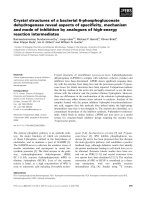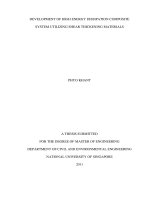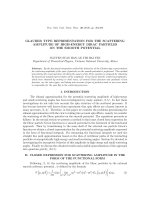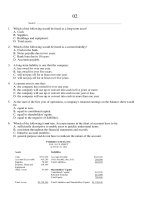Chemistry of high energy materials, 3rd edition
Bạn đang xem bản rút gọn của tài liệu. Xem và tải ngay bản đầy đủ của tài liệu tại đây (6.05 MB, 333 trang )
De Gruyter Graduate
Klapötke · Chemistry of High-Energy Materials
www.pdfgrip.com
Also of interest
Energetic Materials Encyclopedia
Klapötke, 2018
ISBN 978-3-11-044139-0, e-ISBN 978-3-11-044292-2
Interfacial Phenomena and Colloid Stability
Vol. 1 Basic Principles, Vol. 2 Industrial Applications
Tadros, 2015
Set-ISBN 978-3-11-042535-2, e-ISBN 978-3-11-042536-9
Chemical Reaction Technology
Murzin, 2015
ISBN 978-3-11-033643-6, e-ISBN 978-3-11-033644-3
Engineering Risk Management
Meyer, Reniers, 2013
ISBN 978-3-11-028515-4, e-ISBN 978-3-11-028516-1
Nano-Safety: What We Need to Know to Protect Workers
Fazarro, Trybula, Tate, Hanks (Eds.), 2017
ISBN 978-3-11-037375-2, e-ISBN 978-3-11-037376-9
High Temperature Materials and Processes
Hiroyuki Fukuyama (Editor-in-Chief)
ISSN 0334-6455, e-ISSN 2191-0324
www.pdfgrip.com
Thomas M. Klapötke
Chemistry of HighEnergy Materials
3rd Edition
DE GRUYTER
www.pdfgrip.com
Author
Prof. Dr. Thomas M. Klapötke
Ludwig-Maximilians University Munich
Department of Chemistry
Butenandstr. 5–13 (Building D)
81377 Munich, Germany
ISBN 978-3-11-043932-8
e-ISBN (PDF) 978-3-11-043933-5
e-ISBN (EPUB) 978-3-11-043047-9
Library of Congress Cataloging-in-Publication Data
A CIP catalog record for this book has been applied for at the Library of Congress.
Bibliographic information published by the Deutsche Nationalbibliothek
The Deutsche Nationalbibliothek lists this publication in the Deutsche Nationalbibliografie;
detailed bibliographic data are available on the Internet at .
© 2015 Walter de Gruyter GmbH, Berlin/Boston
Cover image: Fischer Test Pb(N3)2 ; provided by Prof. Klapötke
Typesetting: Meta Systems Publishing & Printservices GmbH, Wustermark
Printing and binding: CPI books GmbH, Leck
♾ Printed on acid-free paper
Printed in Germany
www.degruyter.com
www.pdfgrip.com
“We will not waver; we will not tire; we will not falter; and we will not fail.
Peace and freedom will prevail.”
G. W. Bush, Presidential Address to the Nation,
October 7th 2001
www.pdfgrip.com
www.pdfgrip.com
Preface to this 3rd English edition
Everything which has been said in the preface to the first German and first and
second English editions still holds and essentially does not need any addition or
correction. In this revised third edition in English the manuscript has been updated and various recent aspects of energetic materials have been added:
(i) some errors which unfortunately occurred in the first and second editions
have been corrected and the references have also been updated where appropriate.
(ii) The chapters on critical diameters, delay compositions, visible light (blue)
pyrotechnics, polymer-bonded explosives (PBX), HNS, thermodynamic calculations, DNAN, smoke (yellow) formulations and high-nitrogen compounds
have been updated.
(iii) Five new short chapters on Ignition and Initiation (chapters 5.2 and 5.3), the
Plate Dent Test (chapter 7.4), Underwater Explosions (chapter 7.5) and the
Trauzl Test (chapter 6.6) have been added.
In addition to the people thanked in the German and first and second English
editions, the author would like to thank Dr. Vladimir Golubev and Tomasz Witkowski (both LMU) for many inspired discussions concerning hydrocode calculations.
The author is also indebted to and thanks Dr. Manuel Joas (DynITEC, Troisdorf,
Germany) for his help with the preparation of chapters 5.2 and 5.3.
Munich, October 2015
Thomas M. Klapötke
www.pdfgrip.com
Preface to this 2nd English edition
Everything said in the preface to the first German and first English editions still
holds and essentially does not need any addition or correction. In this revised second edition in English we have up-dated the manuscript and added some recent
aspects of energetic materials:
(i) We have tried to correct some mistakes which can not be avoided in a first
edition and also updated the references where appropriate.
(ii) The chapters on Ionic Liquids, Primary Explosives, NIR formulations, Smoke
Compositions and High-Nitrogen Compounds were updated.
(iii) Two new short chapters on Co-Crystallization (9.5) and Future Energetic Materials (9.6) have been added.
In addition to the people thanked in the German and first English edition, the
author would like to thank Dr. Jesse Sabatini and Dr. Karl Oyler (ARDEC, Picatinny
Arsenal, NJ) for many inspired discussions concerning pyrotechnics.
Munich, May 2012
Thomas M. Klapötke
www.pdfgrip.com
Preface to the first English edition
Everything said in the preface to the first German edition remains valid and essentially does not need any addition or correction. There are several reasons for translating this book into English:
– The corresponding lecture series at LMU is now given in English in the postgraduate M.Sc. classes, to account for the growing number of foreign students
and also to familiarize German students with the English technical terms.
– To make the book available to a larger readership world-wide.
– To provide a basis for the authorʼs lecture series at the University of Maryland,
College Park.
We have tried to correct some omissions and errors which can not be avoided in a
first edition and have also updated the references where appropriate. In addition,
five new chapters on Combustion (Ch. 1.4), NIR formulations (Ch. 2.5.5), the Gurney
Model (Ch. 7.3), dinitroguanidine chemistry (Ch. 9.4) and nanothermites (Ch. 13.3)
have been included in the English edition. The chapter on calculated combustion
parameters (Ch. 4.2.3) has been extended.
In addition to the people thanked in the German edition, the author would like
to thank Dr. Ernst-Christian Koch (NATO, MSIAC, Brussels) for pointing out various
mistakes and inconsistencies in the first German edition. For inspired discussions
concerning the Gurney model special thanks goes to Joe Backofen (BRIGS Co., Oak
Hill). Dr. Anthony Bellamy, Dr. Michael Cartwright (Cranfield University), Neha
Mehta, Dr. Reddy Damavarapu and Gary Chen (ARDEC) and Dr. Jörg Stierstorfer
(LMU) are thanked for ongoing discussions concerning secondary and primary explosives.
The author also thanks Mr. Davin Piercey, B.Sc. for corrections and for writing
the new chapter on nanothermites, Dr. Christiane Rotter for her help preparing the
English figures and Dr. Xaver Steemann for his help with the chapter on detonation
theory and the new combustion chapter. The author thanks the staff of de Gruyter
for the good collaboration preparing the final manuscript.
Munich, January 2011
Thomas M. Klapötke
www.pdfgrip.com
Preface to the first German edition
This book is based on a lecture course which has been given by the author for
more than 10 years at the Ludwig-Maximilian University Munich (LMU) in the postgraduate Master lecture series, to introduce the reader to the chemistry of highly
energetic materials. This book also reflects the research interests of the author. It
was decided to entitle the book “Chemistry of High-Energy Materials” and not simply “Chemistry of Explosives” because we also wanted to include pyrotechnics,
propellant charges and rocket propellants into the discussion. On purpose we do
not give a comprehensive historical overview and we also refrained from extensive
mathematical deductions. Instead we want to focus on the basics of chemical explosives and we want to provide an overview of recent developments in the research of energetic materials.
This book is concerned with both the civil applications of high-energy materials (e.g. propellants for carrier or satellite launch rockets and satellite propulsion
systems) as well as the many military aspects. In the latter area there have been
many challenges for energetic materials scientists in recent days some of which
are listed below:
– In contrast to classical targets, in the on-going global war on terror (GWT), new
targets such as tunnels, caves and remote desert or mountain areas have become important.
– The efficient and immediate response to time critical targets (targets that move)
has become increasingly important for an effective defense strategy.
– Particularly important is the increased precision (“we want to hit and not to
miss the target”, Adam Cumming, DSTL, Sevenoaks, U.K.), in order to avoid
collateral damage as much as possible. In this context, an effective coupling
with the target is essential. This is particularly important since some evil regimes often purposely co-localize military targets with civilian centers (e.g. military bases near hospitals or settlements).
– The interest in insensitive munitions (IM) is still one of the biggest and most
important challenges in the research of new highly energetic materials.
– The large area of increasing the survivability (for example by introducing
smokeless propellants and propellant charges, reduced signatures of rocket
motors and last but not least, by increasing the energy density) is another vast
area of huge challenge for modern synthetic chemistry.
– Last but not least, ecological aspects have become more and more important.
For example, on-going research is trying to find suitable lead-free primary explosives in order to replace lead azide and lead styphnate in primary compositions. Moreover, RDX shows significant eco- and human-toxicity and research
is underway to find suitable alternatives for this widely used high explosive.
Finally, in the area of rocket propulsion and pyrotechnical compositions, replacements for toxic ammonium perchlorate (replaces iodide in the thyroid
www.pdfgrip.com
Preface to the first German edition
xi
gland) which is currently used as an oxidizer are urgently needed. Despite all
this, the performance and sensitivity of a high-energy material are almost always the key-factors that determine the application of such materials – and
exactly this makes research in this area a great challenge for synthetically oriented chemists.
The most important aspect of this book and the corresponding lecture series at
LMU Munich, is to prevent and stop the already on-going loss of experience, knowledge and know-how in the area of the synthesis and safe handling of highly energetic compounds. There is an on-going demand in society for safe and reliable
propellants, propellant charges, pyrotechnics and explosives in both the military
and civilian sector. And there is no one better suited to provide this expertise than
well trained and educated preparative chemists.
Last but not least, the author wants to thank those who have helped to make
this book project a success. For many inspired discussions and suggestions the
authors wants to thank the following colleagues and friends: Dr. Betsy M. Rice, Dr.
Brad Forch and Dr. Ed Byrd (US Army Research Laboratory, Aberdeen, MD), Prof.
Dr. Manfred Held (EADS, TDW, Schrobenhausen), Dr. Ernst-Christian Koch (NATO
MSIAC, Brussels), Dr. Miloslav Krupka (OZM, Czech Republic), Dr. Muhamed Sucesca (Brodarski Institute, Zagreb, Croatia), Prof. Dr. Konstantin Karaghiosoff (LMU
Munich), Prof. Dr. Jürgen Evers (LMU Munich), as well as many of the past and
present co-workers of the authors research group in Munich without their help this
project could not have been completed.
The author is also indebted to and thanks Dipl.-Chem. Norbert Mayr (LMU Munich) for his support with many hard- and soft-ware problems, Ms. Carmen Nowak
and Ms. Irene S. Scheckenbach (LMU Munich) for generating many figures and for
reading a difficult manuscript. The author particularly wants to thank Dr. Stephanie Dawson (de Gruyter) for the excellent and efficient collaboration.
Munich, July 2009
Thomas M. Klapötke
www.pdfgrip.com
www.pdfgrip.com
1 Introduction
1.1 Historical Overview
In this chapter we do not want to be exhaustive in scope, but rather to focus on
some of the most important milestones in the chemistry of explosives (Tab. 1.1).
The development of energetic materials began with the accidental discovery of
blackpowder in China (∼ 220 BC). In Europe this important discovery remained
dormant until the 13th and 14th centuries, when the English monk Roger Bacon
(1249) and the German monk Berthold Schwarz (1320) started to research the properties of blackpowder. At the end of the 13th century, blackpowder was finally introduced into the military world. However, it was not until 1425 that Corning greatly
improved the production methods and blackpowder (or gunpowder) was then introduced as a propellant charge for smaller and later also for large calibre guns.
The next milestone was the first small-scale synthesis of nitroglycerine (NG)
by the Italian chemist Ascanio Sobrero (1846). Later, in 1863 Imanuel Nobel and
his son Alfred commercialized NG production in a small factory near Stockholm
(Tab. 1.1). NG is produced by running highly concentrated, almost anhydrous, and
nearly chemically pure glycerine into a highly concentrated mixture of nitric and
sulfuric acids (HNO3 / H 2SO4), while cooling and stirring the mixture efficiently. At
the end of the reaction, the nitroglycerine and acid mixture is transferred into a
separator, where the NG is separated by gravity. Afterwards, washing processes
using water and alkaline soda solution remove any residual acid.
Initially NG was very difficult to handle because of its high impact sensitivity
and unreliable initation by blackpowder. Among many other accidents, one explosion in 1864 destroyed the Nobel factory completely, killing Alfred’s brother Emil.
In the same year, Alfred Nobel invented the metal blasting cap detonator, and
replaced blackpowder with mercury fulminate (MF), Hg (CNO)2 . Although the
Swedish-German Scientist Johann Kunkel von Löwenstern had described Hg (CNO)2
as far back as in the 17th century, it did not have any practical application prior to
Alfred Nobel’s blasting caps. It is interesting to mention that it was not until the
year 2007 that the molecular structure of Hg (CNO)2 was elucidated by the LMU
research team (Fig. 1.1) [1, 2]. Literature also reports the thermal transformation of
MF, which, according to the below equation, forms a new mercury containing explosive product which is reported to be stable up to 120 °C.
3 Hg (CNO)2 → Hg3(C2N2O2)3
After another devastating explosion in 1866 which completely destroyed the NG
factory, Alfred Nobel focused on the safe handling of NG explosives. In order to
reduce the sensitivity, Nobel mixed NG (75 %) with an absorbent clay called “Kieselguhr” (25 %). This mixture called “Guhr Dynamite” was patented in 1867. Despite
www.pdfgrip.com
2
1 Introduction
Tab. 1.1: Historical overview of some important secondary explosives.
substance
acronym
development
application
density/g cm–3
blackpowder
nitroglycerine
BP
NG
1250–1320
1863
ca. 1.0
1.60
170
dynamite
Dy
1867
varies
varies
picric acid
nitroguanidine
trinitrotoluene
nitropenta
hexogen
octogen
PA
NQ
TNT
PETN
RDX
HMX
1885–1888
1877
1880
1894
1920–1940
1943
1425–1900
in propellant
charges
civil/commercial only
WW I
most in TLPs
WW I
WW II
WW II
WW II
100
99
116
167
169
169
1913
1888
1966
1978
1.77
1.71
1.64
1.77
1.81
1.91
(β polymorph)
1.74
1.93
1987
under evaluation
hexanitrostilbene HNS
triaminotrinitroTATB
benzene
HNIW
CL-20
a
explosive
power b
2.1
(ε polymorph)
rel. to PA
C
O
N
C
N
O
Hg
Fig. 1.1: Molecular structure of mercury fulminate, Hg (CNO)2.
CH2ONO2
H
H C O NO2
H C O NO2
H C O NO2
H
NG
H
ONO2
C
C H
O
H C
O
ONO2 H
H
C
C
C
H
ONO2 H
O
O
H
H
C
O
C
C
C
H
CH2ONO2
ONO2
n
NC
Fig. 1.2: Molecular structures of nitroglycerine (NG) and nitrocellulose (NC).
the great success of dynamite in the civil sector, this formulation has never found
significant application or use in the military sector.
One of the great advantages of NG (Fig. 1.2) in comparison to blackpowder
(75 % KNO3 , 10 % S8 , 15 % charcoal) is that it contains both the fuel and oxidizer
in the same molecule which guarantees optimal contact between both components,
www.pdfgrip.com
1.1 Historical Overview
3
whereas in blackpowder, the oxidizer (KNO3) and the fuel (S8 , charcoal) have to
be physically mixed.
At the same time as NG was being researched and formulated several other
research groups (Schönbein, Basel and Böttger, Frankfurt-am-Main) worked on the
nitration of cellulose to produce nitrocellulose (NC). In 1875 Alfred Nobel discovered that when NC is formulated with NG, they form a gel. This gel was further
refined to produce blasting gelatine, gelatine dynamite and later in 1888 ballistite
(49 % NC, 49 % NG, 2 % benzene and camphor), which was the first smokeless
powder. (Cordite which was developed in 1889 in Britain, had a very similar composition.) In 1867 it was proven that mixtures of NG or dynamite and ammonium
nitrate (AN) showed enhanced performance. Such mixtures were used in the civil
sector. In 1950 manufacturers started to develop explosives which were waterproof
and solely contained the less hazardous AN. The most prominent formulation was
ANFO (Ammonium Nitrate Fuel Oil) which found extensive use in commercial
areas (mining, quarries etc.). Since the 1970s aluminium and monomethylamine
were added to such formulations to produce gelled explosives which could detonate more easily. More recent developments include production of emulsion explosives which contain suspended droplets of a solution of AN in oil. Such emulsions
are water proof, yet readily detonate because the AN and oil are in direct contact.
Generally, emulsion explosives are safer than dynamite and are simple and cheap
to produce.
Picric acid (PA) was first reported in 1742 by Glauber, however it was not used
as an explosive until the late 19th century (1885–1888), when it replaced blackpowder in nearly all military operations world-wide (Fig. 1.3). PA is prepared best by
dissolving phenol in sulfuric acid and the subsequent nitration of the resulting of
phenol-2,4-disulfonic acid with nitric acid. The direct nitration of phenol with nitric
acid is not possible because the oxidizing HNO3 decomposes the phenol molecule.
Since the sulfonation is reversible, the —SO3 H groups can then be replaced with
—NO2 groups by refluxing the disulfonic acid in concentrated nitric acid. In this
step the third nitro group is introduced as well. Although pure PA can be handled
safely, a disadvantage of PA is its tendency to form impact sensitive metal salts
(picrates, primary explosives) when in direct contact with shell walls. PA was used
as a grenade and as mine filling.
Tetryl was developed at the end of the 19th century (Fig. 1.3) and represents
the first explosive of the nitroamino (short: nitramino) type. Tetryl is best obtained
by dissolving monomethylaniline in sulfuric acid and then pouring the solution
intro nitric acid, while cooling the process.
The above mentioned disadvantages of PA are overcome by the introduction of
trinitrotoluene (TNT). Pure 2,4,6-TNT was first prepared by Hepp (Fig. 1.3) and its
structure was determined by Claus and Becker in 1883. In the early 20th century
TNT almost completely replaced PA and became the standard explosive during WW
I. TNT is produced by the nitration of toluene with mixed nitric and sulfuric acid.
www.pdfgrip.com
4
1 Introduction
H3C
OH
O2N
NO2
N
NO2
O2N
NO2
NO2
NO2
Tetryl
NH2
H2N C
N NO2
TNT
O2N O H2C CH2 O NO2
C
O2N O H2C CH2 O NO2
NQ
PETN
O2N
NO2
H2C
N
N
C
H2
CH2
N
NO2
O2N
N
N
NO2
CH2
C N
H2
NO2
HMX
NO2
O2N
NO2
C
H
NO2
H2
N C
H2C
RDX
O2N
O2N
NO2
PA
O2N
CH3
NO2
H
C
H2N
NH2
O2N
NO2
NO2
O2N
NH2
HNS
TATB
Fig. 1.3: Molecular structures of picric acid (PA), tetryl, trinitrotoluene (TNT), Nitroguanidine (NQ),
pentaerythritol tetranitrate (PETN), hexogen (RDX), octogen (HMX), hexanitrostilbene (HNS) and
triaminotrinitrobenzene (TATB).
For military purposes TNT must be free of any isomer other than the 2,4,6-nisomer.
This is achieved by recrystallization from organic solvents or from 62 % nitric acid.
TNT is still one of the most important explosives for blasting charges today. Charges are produced through casting and pressing. However, cast charges of TNT often
show sensitivity issues and do not comply with the modern insensitive munition
requirements (IM). For this reason alternatives to TNT have been suggested. One of
these replacements for TNT is NTO (filler) combined with 2,4-dinitroanisole (DNAN,
binder).
www.pdfgrip.com
1.1 Historical Overview
5
Nitroguanidine (NQ) was first prepared by Jousselin in 1887 (Fig. 1.3). However, during WW I and WW II it only found limited use, for example in formulations
with AN in grenades for mortars. In more recent days NQ has been used as a component in triple-base propellants together with NC and NG. One advantage of the
triple-base propellants is that unlike double-base propellants the muzzle flash is
reduced. The introduction of about 50 % of NQ to a propellant composition also
results in a reduction of the combustion temperature and consequently reduced
erosion and increased lifetime of the gun. NQ can be prepared from dicyandiamide
and ammonium nitrate via guanidinium nitrate which is dehydrated with sulfuric
acid under the formation of NQ:
H2N
N
C
H2N
NH4NO3
C
N
ȕH2N
CN
C(NH2)3 NO3
H2SO4
ȕH2O
NH2
H2N C
N NO2
The most widely used explosives in WW II other than TNT were hexogen (RDX)
and pentaerythritol tetranitrate (nitropenta, PETN) (Fig. 1.3). Since PETN is more
sensitive and chemically less stable than RDX, RDX was (and is) the most commonly used high explosive. PETN is a powerful high explosive and has a great shattering effect (brisance). It is used in grenades, blasting caps, detonation cords and
boosters. PETN is not used in its pure form because it is too sensitive. A formulation
of 50 % TNT and 50 % PETN is known as “pentolite”. In combination with plasticized nitrocellulose PETN is used to form polymer bonded explosives (PBX). The
military application of PETN has largely been replaced by RDX. PETN is prepared
by introducing pentaerythritol into concentrated nitric acid while cooling and stirring the mixture efficiently. The then formed bulk of PETN crystallizes out of the
acid solution. The solution is then diluted to about 70 % HNO3 in order to precipitate the remaining product. The washed crude product is purified by recrystallization from acetone.
Hexogen (RDX) was first prepared in 1899 by Henning for medicinal use. (N.B.
NG and PETN are also used in medicine to treat angina pectoris. The principal
action of these nitrate esters is vasodilation (i.e. widening of the blood vessels).
This effect arises because in the body the nitrate esters are converted to nitric oxide
(NO) by mitochondrial aldehyde dehydrogenase, and nitric oxide is a natural vasodilator.) In 1920 Herz prepared RDX for the first time by the direct nitration of
hexamethylene tetramine. Shortly afterwards Hale (Picatinny Arsenal, NJ) developed a process that formed RDX in 68 % yield. The two processes most widely used
in WW II were
1. the Bachmann process (KA process) in which hexamethylene tetramine dinitrate reacts with AN and a small amount of nitric acid in an acetic anhydride
medium to form RDX (type B RDX). The yields are high, however, 8–12 % of
HMX form as a side product.
2. the Brockman process (type A RDX) essentially produces pure RDX.
www.pdfgrip.com
6
1 Introduction
Tab. 1.2: Composition of some high explosive formulations.
name
composition
Composition A
Composition B
Composition C4
octol
torpex b
PBXN-109
OKFOL
88.3 % RDX, 11.7 % non-energetic plasticizers
60 % RDX, 39 % TNT, 1 % binder (wax)
90 % RDX, 10 % polyisobutylene
75 % HMX, 25 % RDX
42 % RDX, 40 % TNT, 18 % aluminum
64 % RDX, 20 % aluminum, 16 % binder
96.5 % HMX, 3.5 % wax
a
An Australian improved development of torpex is known under the name H6 and also contains hexogen (RDX), trinitrotoluene (TNT) and aluminum. H6 was used as a high explosive formulation in the
MOAB bomb (Massive Ordnance Air Blast bomb). MOAB (also known as GBU-43/B) is with a load of
approx. 9500 kg high explosive formulation one of the largest conventional bombs ever used.
After WW II octogen (HMX) started to become available. Until today, most high
explosive compositions for military use are based on TNT, RDX and HMX (Tab. 1.2).
Since 1966 hexanitrostilbene (HNS) and since 1978 triaminotrinitrobenzene
(TATB) are produced commercially (Fig. 1.3). Both secondary explosives show excellent thermal stabilities and are therefore of great interest for the NAVY (fuel
fires) and for hot deep oil drilling applications (Fig. 1.3). Especially HNS is known
as a heat- and radiation-resistant explosive which is used in heat-resistant explosives in the oil industry. The brisance of HNS is lower than that of RDX, but the
melting point of approx. 320 °C is much higher. HNS can directly be prepared from
trinitrotoluene through oxidation with sodium hypochlorite in a methanol/THF solution:
2 C6 H 2(NO2)3CH 3 + 2 NaOCl → C6 H 2(NO2)3—CH═CH—C6 H 2(NO2)3 + 2 H 2O + 2 NaCl
Since oil deposits which are located closer to the surface are becoming rare, deeper
oil reserves now have to be explored where (unfortunately) higher temperatures
are involved. Therefore, there is an ongoing search for explosives which are even
more thermally stable (decomposition temperatures > 320 °C) than HNS, but at the
same time show better performance (Tab 1.2a). Higher thermal stabilities usually
result in compounds with lower sensitivities which are therefore safer to handle.
According to J. P. Agrawal, new energetic materials with high thermal stabilities can be achieved by incorporating the following points in the compounds:
– Salt formation
– Introduction of amino groups
– Introduction of conjugation
– Condensation with a triazole ring.
Two possible replacements for HNS which are presently under investigation are
PYX and PATO.
Various picryl and picrylamino substituted 1,2,4–triazoles which were formed
by condensing 1,2,4-triazole or amino-1,2,4-triazole with picryl chloride (1-chloro-
www.pdfgrip.com
7
1.1 Historical Overview
Tab. 1.2a: Desired properties of potential HNS replacements
Thermal Stability
Detonation Velocity
Specific Energy *
Impact Sensitivity
Friction Sensitivity
Total Costs
Critical diameter
No changes after 100 h at 260 °C
> 7500 m/s
> 975 kJ/kg
> 7.4 J
> 235 N
< 500 Euro/kg
≥ HNS
* specific energy. F = pe · V = n · R · T
O2N
NO2
O2N
HN
N
NO2
HN
O2N
O2N
N
O2N
N
H
O2N
HN
N
NO2
NO2
3-picrylamino-1,2,4-triazole (PATO)
m.p. 310 ºC
O2N
2,6-Bis(picrylamino)-3,5-dinitro-pyridine (PYX)
m.p. 360 ºC
Fig. 1.3a: Molecular structures of PATO and PYX.
2,4,6-trinitrobenzene) were studied in detail by Coburn & Jackson. One of these
molecules is PATO (3-picrylamino-1,2,4-triazole), a well known, thermally stable
explosive, which is obtained by the condensation of picryl chloride with 3-amino1,2,4-triazole (Fig. 1.3a). Another promising candidate for a high-temperature explosive is PYX (Fig. 1.3a). The synthesis for PYX is shown in Fig. 1.3b.
Agrawal et al. reported the synthesis of BTDAONAB (Fig. 1.3c) which does not
melt below 550 °C and is considered to be a better and thermally more stable explosive than TATB. According to the authors, this material has a very low impact (21 J),
no friction sensitivity (> 360 N) and is thermally stable up to 550 °C. These reported
properties makes BTDAONAB superior to all of the nitro-aromatic compounds
which have been discussed. BTDAONAB has a VoD of 8300 m/s while TATB is
about 8000 m/s [Agrawal et al., Ind. J. Eng. & Mater Sci., 2004, 11, 516–520; Agrawal et al., Central Europ. J. Energ. Mat. 2012, 9(3), 273–290.]
Moreover, recently another nitro-aromatic compound (BeTDAONAB), similar to
Agrawal’s BTDAONAB has been published by Keshavaraz et al., which is also very
www.pdfgrip.com
8
1 Introduction
O2N
NO2
O2N
Cl
O
OH
O 2N
NO2
NO2
NO2
NO2
POCl3
Pyridine
NO2
N
H
NaF
O 2N
NO2
NO2
HN
NO2
O 2N
N
N
H2N
NO2
NO2
HNO3
NH
NO2
HN
O2N
NO2
N
NO2
O2N
NH2
NH
O2N
NO2
Fig. 1.3b: Synthetic route for PYX.
O2N
NO2
NO2
O2N
N
H N
N
N
N
H
O2N
N
N
N
H
NO2
O2N
N
N H
NO2
Fig. 1.3c: Molecular structure of BTDAONAB.
insensitive (Fig 1.3d). In this compound, the terminal triazole moieties have been
replaced by two more energetic (more endothermic) tetrazole units [Keshavaraz et
al., Central Europ. J. Energ. Mat. 2013, 10(4), 455; Keshavaraz et al., Propellants,
Explos. Pyrotech., DOI: 10.1002/prep.201500017]. Table 1.2b shows a comparison of
the thermal and explosive properties of TATB, HNS, BTDAONAB and BeTDAONAB.
Tab. 1.2b: Comparative data of the thermal and explosive properties of TATB, HNS, BTDAONAB and
BeTDAONAB.
Property
TATB
HNS
BTDAONAB
BeTDAONAB
density / g/cc
Sensitivity to temperature / °C
DTA (exo) / °C
DSC (exo) / °C
ΩCO / %
IS / J
FS / N
VoD / m s–1
pC–J / kbar
1.94
360
360
371
–18.6
50
> 353
7900
273
1.74
318
353
350
–17.8
5
240
7600
244
1.97
350
550
1.98
260
275
268
–5.9
21
362
8700
354
www.pdfgrip.com
–6.8
21
353
8600
341
9
1.1 Historical Overview
Nitration
92-95 ºC
4h
COOH
COOH
O2N
O2N
NO2
NO2
Cl
Cl
4-Chloro-3,5-dinitrobenzoic acid
4-Chloro-3,5-dinitroaniline
Cl
4-Chlorobenzoic acid
NH2
Oleum, NaN3
reflux, 4 h
Nitration
85-90 ºC
2.5 h
O2N
Cl
O 2N
NO2
N
NO2
O2N
N
O2N
NO2
Cl
NO2
4,4'-Dichloro-2,2',3,3',5,5',6,6'-octanitroazobenzene (DCONAB)
5-Amino-1,2,3,4-tetrazole
Reflux, 5 h
O2N
N N
N
N
H
N
H
O2N
NO2
N
NO2
O2N
N
O2N
NO2
N
H
NO2
N N
N
H
N
Fig. 1.3d: Synthetic route for the synthesis of BeTDAONAB.
TATB is obtained from trichloro benzene by nitration followed by a reaction
of the formed trichlorotrinitro benzene with ammonia gas in benzene or xylene
solution.
As shown above, the number of chemical compounds which have been used
for high explosive formulations until after WW II is relatively small (Tab. 1.1 and
1.2). As we can also see from Table 1.1 and 1.2 the best performing high explosives
(RDX and HMX; TNT is only used because of its melt-cast applications) possess
relatively high densities and contain oxidizer (nitro and nitrato groups) and fuel
(C—H back bone) combined in one and the same molecule. One of the most powerful new high explosive is CL-20 which was first synthesized in 1987 by the Naval
Air Warfare Center (NAWF) China Lake (Fig. 1.7, Tab. 1.1). CL-20 is a cage compound
with significant cage strain which also contains nitramine groups as oxidizers and
possesses a density of about 2 g cm–3. This already explains the better performance
www.pdfgrip.com
10
1 Introduction
in comparison with RDX and HMX. However, due to the relatively high sensitivity
of the (desirable) ε polymorph as well as possible phase transition problems and
high production costs so far CL-20’s wide and general application has not been
established.
1.2 New Developments
1.2.1 Polymer-Bonded Explosives
Since about 1950 polymer-bonded (or plastic-bonded) explosives (PBX) have been
developed in order to reduce sensivity and to facilitate safe and easy handling. PBX
also show improved processibility and mechanical properties. In such materials
the crystalline explosive is embedded in a rubber-like polymeric matrix. One of the
most prominent examples of a PBX is Semtex. Semtex was invented in 1966 by
Stanislav Brebera, a chemist who worked for VCHZ Synthesia in Semtin (hence the
name Semtex), a suburb of Pardubice in the Czech Republic. Semtex consists of
varying ratios of PETN and RDX. Usually polyisobutylene is used for the polymeric
matrix, and phthalic acid n-octylester is the plasticizer. Other polymer matrices
which have been introduced are polyurethane, polyvinyl alcohol, PTFE (teflon),
Viton, Kel-F and various polyesters.
Often, however, problems can arise when combining the polar explosive (RDX)
with the non-polar polymeric binder (e.g. polybutadiene or polypropylene). In order to overcome such problems, additives are used to facilitate mixing and intermolecular interactions. One of such polar additives is dantacol (DHE) (Fig. 1.4).
O
HO
N
N
OH
O
Fig. 1.4: Structure of Dantacol (DHE).
One disadvantage of the polymer-bonded explosives of the first generation, is
that the non-energetic binder (polymer) and plasticizer lessened the performance.
To overcome this problem energetic binders and plasticizers have been developed.
The most prominent examples for energetic binders are (Fig. 1.5, a):
– poly-GLYN, poly(glycidyl)nitrate
– poly-NIMMO, poly(3-nitratomethyl-3-methyl-oxetane)
– GAP, glycidylazide polymer
– poly-AMMO, poly(3-azidomethyl-3-methyl-oxetane),
– poly-BAMO, poly(3,3-bis-azidomethyl-oxetane).
www.pdfgrip.com
1.2 New Developments
CH3
H2C O NO2
CH2
CH
O
O
CH2
H2C N3
C
CH2
CH2
poly-GLYN
CH2
C
O
CH2
n
H2C
CH2
CH2
O
H3C
NO2
O
(b)
CH2
CH
O
O
NO2
NO2
MTN
NO2
CH2
CH2
O
NO2
H2C
O
NO2
H2C
O
NO2
BTTN
EGDN
N
R NH2 e CH2O e NH3
NO2
CH2
NENA
O
n
O
C
H2C
O2N
CH2
poly-BAMO
NO2
N
C
H2C N3
poly-AMMO
R
n
GAP
H2C N3
CH2
H2C N3
(a)
O
H
poly-NIMMO
CH3
O
C
H2C O NO2 n
n
NH4NO3
e
N
N
N R
ȕ
NO3
R q Me (92 %)
Et (90 %)
CH2CH2OH (82 %)
Ac2O / HNO3
R q Me (72 %)
Et (80 %)
CH2CH2ONO2 (76 %)
AcO
N
N
N
NO2
NO2
NO2
R
HCl / CF3COOH
R q Me (85 %)
Et (85 %)
CH2CH2ONO2 (55 %)
Cl
N
N
N
NO2
NO2
NO2
R
NaN3 /acetone
R q Me (78 %)
Et (88 %)
CH2CH2ONO2 (82 %)
N3
N3
azide
N
N
N
NO2
NO2
NO2
N
N
N
NO2
NO2
NO2
R
ONO2
nitrato
nitramine
(c)
ANTTO
Fig. 1.5: Energetic binders (a) and energetic plasticizers (b). Synthesis of the NENA compound,
ANTTO (c).
www.pdfgrip.com
11
12
1 Introduction
Examples for energetic plasticizers are (Fig. 1.5, b):
– NENA derivatives, alkylnitratoethylnitramine,
– EGDN, ethyleneglycoldinitrate,
– MTN, metrioltrinitrate,
– BTTN, butane-1,2,4-trioltrinitrate.
For binders in particular − but also for plasticizers − it is important to know the
glass transition temperature. The value of the glass transition temperature should
be as low as possible but at least −50 °C. If the temperature of a polymer drops
below Tg, it behaves in an increasingly brittle manner. As the temperature rises
above Tg, the polymer becomes more rubber-like. Therefore, knowledge of Tg is
essential in the selection of materials for various applications. In general, values
of Tg well below room temperature correspond to elastomers and values above
room temperature to rigid, structural polymers.
In a more quantitative approach for the characterization of the liquid-glass
transition phenomenon and Tg, it should be noted that in cooling an amorphous
material from the liquid state, there is no abrupt change in volume such as that
which occurs on cooling a crystalline material below its freezing point, Tf. Instead,
at the glass transition temperature, Tg, there is a change in the slope of the curve
of specific volume vs. temperature, moving from a low value in the glassy state to
a higher value in the rubbery state over a range of temperatures. This comparison
between a crystalline material (1) and an amorphous material (2) is illustrated in
the figure below. Note that the intersection of the two straight line segments of
curve (2) defines the quantity Tg (Fig. 1.5a).
Specific volume
Liquid
2
1
Rubbery
state
Glassy state
Crystalline state
Temperature
Tg
Tf
Fig. 1.5a: Specific volume vs. temperature plot for a crystalline solid and a glassy material with a
glass transition temperature (Tg).
www.pdfgrip.com









